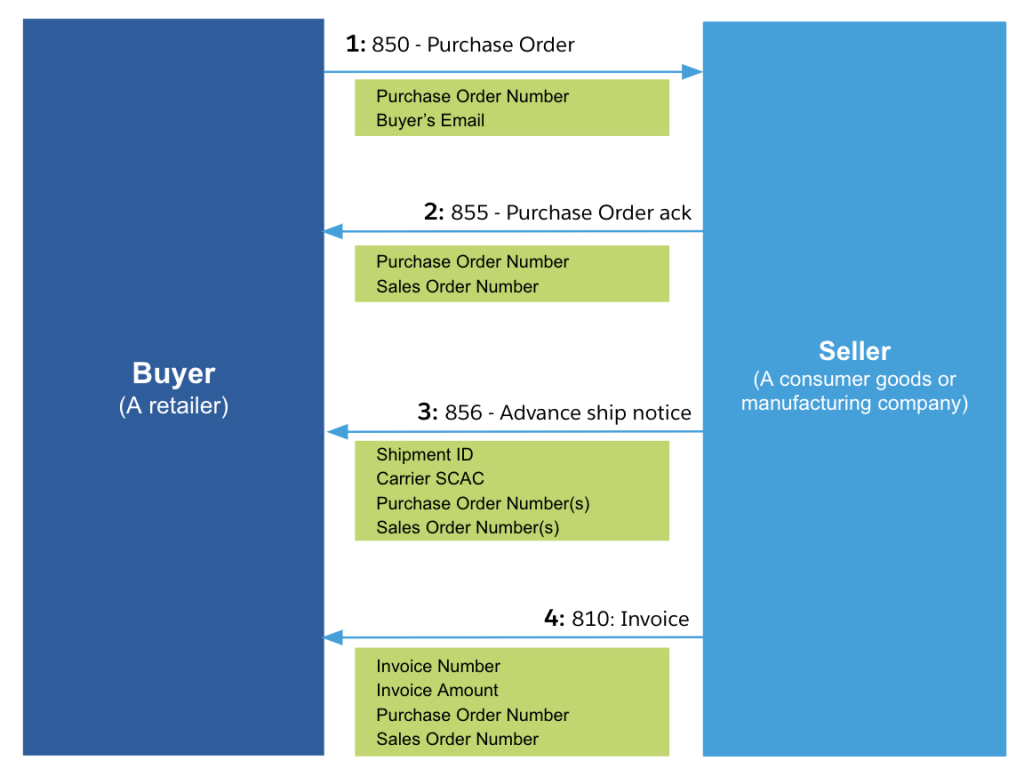Since the onset of the COVID-19 pandemic, organizations across industries are taking measures to be resilient to crisis situations and expand their supply chain business partner network to better serve their customers. The ability to exchange critical business transactions with the business partner ecosystem in a timely manner and have real-time visibility to the transaction lifecycle is considered critical.
The lifecycle of a B2B transaction
B2B integrations enable the automation of end-to-end business process workflows and almost always involve a series of messages exchanged between the two parties involved in the business. B2B procure-to-pay, order-to-cash, logistics planning, transportation execution, and warehouse management are key functions within supply chain management that rely extensively on B2B integrations.
A typical B2B order-to-cash workflow between a buyer and a seller involves exchanging purchase orders (PO), PO acknowledgements, advance ship notices, and invoices. It is also very common for organizations to exchange other transactions, such as inventory, price catalog, purchase order change requests, change acknowledgements, and more.
Apart from the direct order-to-cash workflows, the order fulfillment and delivery may involve integrations with third-party logistics providers or transportation carriers to request freight transportation services and get real time shipment status updates.
Each B2B message contains key attributes such as a PO number, sales order number, shipment ID, invoice number and more – regardless of whether the exchange happens using EDI standards such as X12 and EDIFACT, or using API based exchange with XML and JSON message formats.

The need for better B2B transaction visibility
As organizations trade with hundreds of business partners, it is critical to have the ability to search for specific messages based on any of the key fields within the data to troubleshoot problems and to get better operational insights to make informed business decisions.
Key considerations
When thinking about extracting key fields from B2B message payloads, we need to have the following key considerations:
- The fields to be extracted can be present anywhere within the message payloads.
- There can be more than one field that is critical for business and operational users that need to be extracted for specific message types.
- E.g. An invoice contains an invoice number, PO number, and sales order number that are critical to the business and operational users. For some organizations, fields such as Payment Terms or Payment Method may be important to capture and search/filter messages based on these fields.
- In some cases, there can be more than just one value for the same attribute within the same message payload
- E.g. An Advance Ship Notice message contains one Shipment ID, but may have multiple PO numbers if the supplier is sending a consolidated shipment with items from multiple orders.
What’s new in Anypoint Partner Manager?
Anypoint Partner Manager’s June 2022 release enables enhanced visibility into B2B transactions exchanged with business partners.
Users can now define custom message attributes to be extracted at runtime, and have them attached to the transaction metadata along with a label.
- Partner Manager leverages a flexible framework with Dataweave allowing users to map message attributes from anywhere within the payload.
- Attributes can be reused across multiple message types
Users can search for messages with specific attribute labels and values, essentially getting an end-to-end visibility into a particular transaction’s full lifecycle.

B2B transaction visibility with custom attributes
When messages are processed and exchanged with trading partners in the runtime, the defined attribute fields are extracted and reported along with the transaction metadata, allowing users to search for specific message attributes.
When searching for specific attributes, users get visibility messages of different types with the same attribute value, providing an end-to-end view of all the messages exchanged through the lifecycle of the transaction.
For example, when searching for a specific PO number, the search result includes all the messages with the same PO number, such as the inbound purchase order, outbound PO acknowledgement, advance ship notice, invoices, and more.
Leverage custom attributes beyond standard search
In addition to being able to search for messages with specific attribute values within Partner Manager’s UI, customers can also consume the platform tracking API to access the same information. This can be handy when we need to build any custom monitoring or correlation solutions externally to improve supply chain operational efficiency.
Watch a detailed demo of these new features: Full lifecycle B2B transaction visibility to discover what’s new in MuleSoft’s Anypoint Partner Manager!
Want to know more?
Learn more about how you can rapidly accelerate B2B trading partner onboarding to exchange business transactions via both traditional EDI and modern API based channels through a low-code experience. You can also sign up with Anypoint Platform for free and contact your account representative to try Anypoint Partner Manager.









